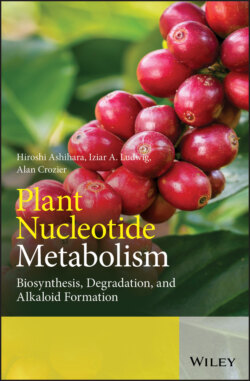Читать книгу Plant Nucleotide Metabolism - Hiroshi Ashihara - Страница 43
3.4.3 Nucleoside-Diphosphate Kinase
ОглавлениеUsing cellular ATP, purine and pyrimidine nucleoside triphosphate are produced by nucleoside-diphosphate kinase (EC 2.7.4.6). The enzyme catalyses the reaction: nucleoside diphosphate + ATP ↔ nucleoside triphosphate + ADP. Substrate specificity is broad. All purine and pyrimidine nucleoside diphosphates can act as acceptors, while not only ATP, but also any ribonucleoside- and deoxyribonucleoside triphosphate, can act as a donor. This enzyme contributes principally to the formation of nucleoside triphosphates, such as GTP, uridine-triphosphate (UTP) and cytidine-triphosphate (CTP), from the respective nucleoside-diphosphates. Nucleoside-diphosphate kinase occurs ubiquitously in animals, plants, and bacteria. Recent molecular genetic studies suggest that nucleoside-diphosphate kinases are major players in the synthesis of macromolecules since they provide the triphosphates used for cell anabolism, including nucleic acid synthesis, CTP for lipid synthesis, UTP for polysaccharide synthesis, and GTP for protein elongation, signal transduction, and microtubule polymerization. Five nucleoside-diphosphate kinase genes have been detected in Arabidopsis thaliana and rice (Oryza sativa). Cytosolic (type I) and chloroplast (type II) enzymes are involved in metabolism, growth, and stress responses and in photosynthetic development and oxidative stress management, respectively. Type III enzymes are located in mitochondria and chloroplasts and are involved principally in energy metabolism. The subcellular localization and precise function of the novel type IV enzyme has not as yet been determined (Dorion and Rivoal 2015).
Figure 3.3 Glycolysis in plants. (1) Hexokinase; (2) phosphoglucoisomerase; (3a) phosphofructokinase; (3b) pyrophosphate dependent-fructose-6-phosphate 1-phosphotransferase; (4) aldolase; (5) triose phosphate isomerase; (6) glyceraldehyde-3-phosphate dehydrogenase; (7) phosphoglycerate kinase; (8) phosphoglycerate mutase; (9) enolase; (10) pyruvate kinase; (11) amylase etc.; (12) starch phosphorylase; (13) invertase; (14) sucrose synthase; (15) phosphoglucomutase; (16) UDP-glucose pyrophosphorylase; (17) fructokinase. Note: Fructose* produced from sucrose (reaction 13) is converted to fructose-6-P (reaction 17).
Figure 3.4 Reactions involved in the substrate level ATP production and consumption. (1) succinyl CoA synthetase; (2) hexokinase; (3) phosphofructokinase; (4) phosphoglycerate kinase; (5) pyruvate kinase.
